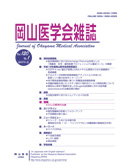

Journal of Okayama Medical Association
Published by Okayama Medical Association<Availability>
Full-text articles are available 3 years after publication.
Permalink : https://ousar.lib.okayama-u.ac.jp/41364
腸管内bilirubinの還元過程に関する研究 第1編 屎中bilirubinoideの分離について
今井 春路郎
岡山大学医学部第一内科教室
発行日
1959-11-30
抄録
Bilirubinoide in the feces of various patients was separated by column chromatography. And the results were as follows. 1. Bilirubin and urobilin could be separated from the feces of various patients, but other bilirubinoide was only identified by the absorption curves because of the scanty dosis. 2. Bilirubin, mesobilirubin, dihydromesobilirubin and urobilin were separated from the feces of 6 cases in the 8 cases with the administration of antibiotics for a long period, and bilirubin, dihydrobilirubin, mesobilirubin and urobilinogen in other one case and bilirubin, dihydromesobilirubin in another case. 3. In the above 2 cases with the administration of antibiotics, mesobilirhodin and mesobiliviolin were identified in the mixture of urobilin, but each fraction of them could be scarcely separated. Since dihydromesobilirubin was separated at that time, it was thought that mesobilirhodin and mesobiliviolin were produced by the oxydation of dihydromesoblilirubin during the separation process. Therefore, it was thought that dihydromesobilirubin produced in the intestine was composed of two isomerides. 4. The formation of urobilinogen in the intestine was supposed to take the same reduction process of bilirubin by colloidal palladium in vitro.
ISSN
0030-1558
NCID
AN00032489
